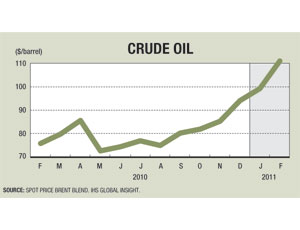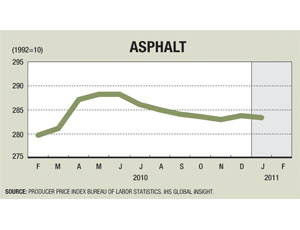Asphalt prices, which had largely flat-lined in the last 12 months, were shocked back to life in March by a run-up in oil prices fueled by the recent political turmoil in the Middle East. Highway contractors are guessing at whether hard-to-predict asphalt prices will continue to follow oil in upcoming months, something that doesn’t always happen.


Asphalt prices are not only tied to light crude oil. They also follow heavy crude supply—which tracks differently than light crude—and demand tied to federal, state and local transportation funding. Given the current emphasis on reining in spending, heavy budgetary pressure could tip the transportation market back into a recessionary status.
The Bureau of Labor Statistics producer price index shows prices for asphalt paving mixtures remaining stable during the last 12 months (see chart). However, it is a different story for the bulk bitumen asphalt. In March several state transportation departments increased their estimates for the cost of bitumen asphalt to the $500-per-ton range, or more, after prices had lingered around $450 per ton since last July.
Prior to this spring’s hike, asphalt prices were slowly easing, after jumping 3.4% in July, says economist Robert Martin at Washington, D.C.-based IHS Global Insight. “The recent increase is the first uptick in six months. Typically, asphalt does not track one-to-one with oil prices, but in this case the increase is likely influenced by the current rise in oil prices,” Martin says. With light crude edging past $100 per barrel in March, and asphalt rapidly following, Martin predicts “asphalt may likely continue to track with oil the rest of this year.”
Many county and city government are facing “a 20% increase” in asphalt prices, says Doug Moser, construction inspection chief for Idaho Falls, Idaho. “Give it another few weeks and with the instability in the Middle East it could go higher.”
“现在有很多不确定性和沥青d with fuel costs, and we suspect this is not the end [of higher prices],” says Georgia Dept. of Transportation engineer Thomas Mims. The asphalt price tracked by Georgia DOT climbed from $440 a ton last January to $500 a ton this month. As a result, “we are really prioritizing what we pave this year,” says Mims.
Town and counties around the country are reacting to the prospect of a summer-long increase for asphalt prices in various ways, including cutting programs, partnering with other municipalities for cost-sharing and eyeing alternative materials.
In Corpus Christi, Texas, city engineer Kevin Stowers says concrete road surfaces are being considered a less costly alternative to asphalt. “We can get the same life-cycle results with concrete and asphalt. It is simply [a matter of] which is the better price,” says Stowers.
Contractors are clamoring for public work as private sector demand shrinks with higher asphalt and fuel costs, says Gary Linde, vice president at Honesdale, Pa.-based Leeward Construction Inc. The rising costs have had a chilling effect on private project opportunities in the region, and “the volatility in asphalt and diesel costs are a constant challenge,” Linde says. Rising construction costs forced the company this year to make a concerted switch from bidding mostly on private paving projects to looking at government-funded projects for nearly three-fourths of its current work.
As a derivative of heavy crude, asphalt prices are subject to factors independent of those affecting light-crude products like diesel and gasoline, notes Simon Wardell, senior oil analyst at IHS Global Insight. “The higher the prices go the less correlation there will be between oil and asphalt prices,” Wardell says, pointing to such factors as Japan’s loss of two refineries that specialized in heavy crude following the earthquake and tsunami. Coupled with falling demand on rising prices, “it will create excess supply of heavy crude in the market worldwide, which in the long term could push prices down.”
